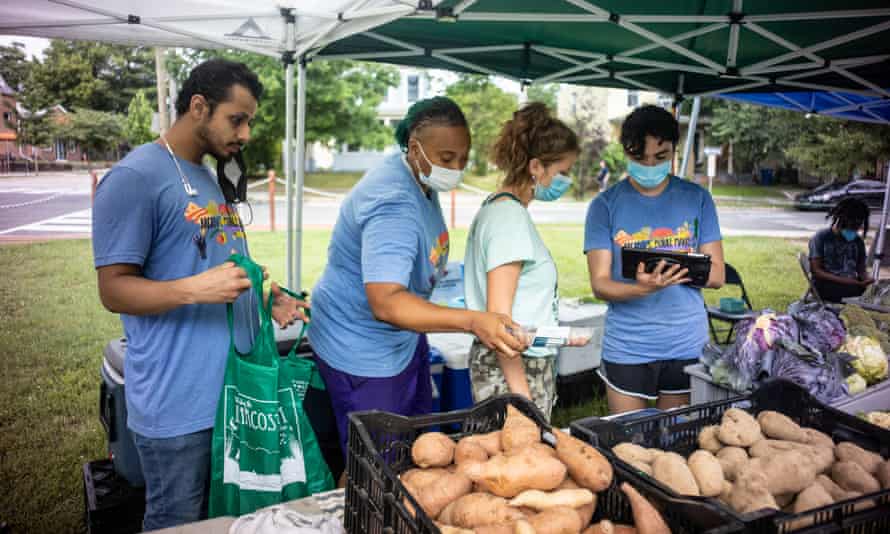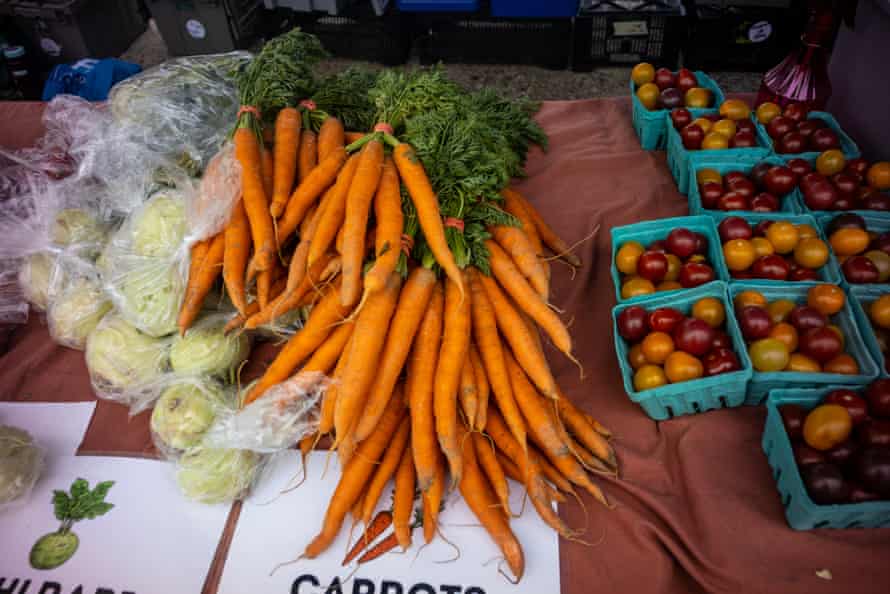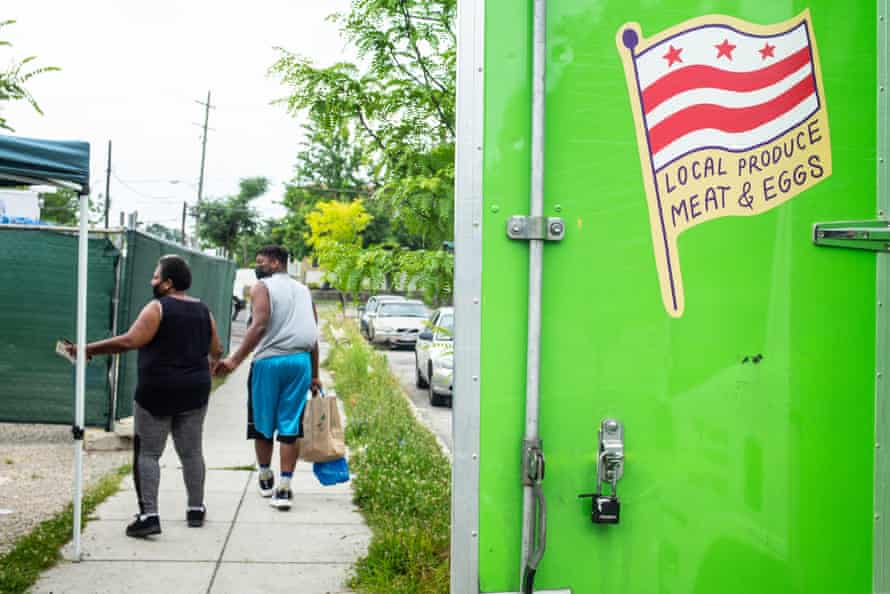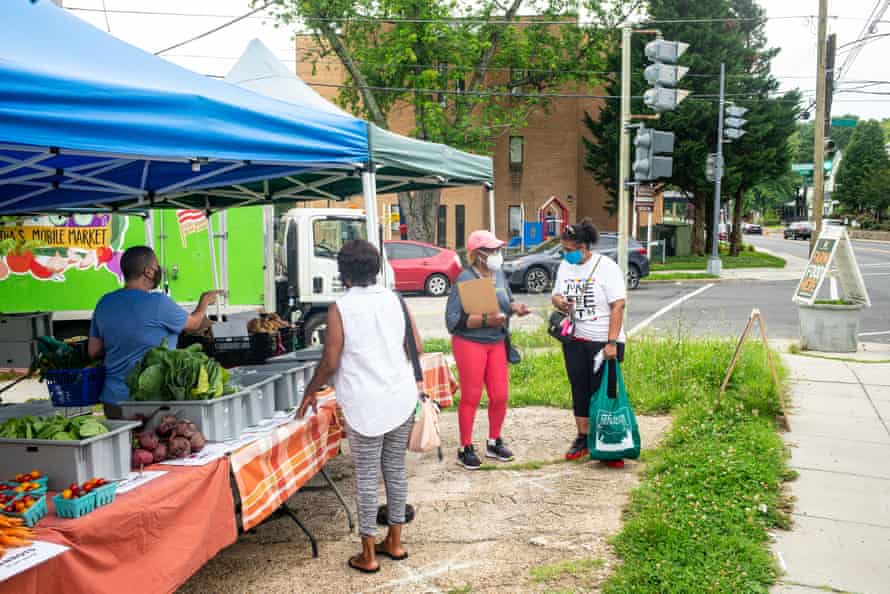The farmers’ market on wheels tackling one of America’s worst food deserts
A mobile market is helping to get healthy food into neighborhoods otherwise full of ‘fringe’ food stores like liquor shops

Last modified on Sat 17 Jul 2021 07.21 EDT
“I like the purple cabbage,” says Matinah Muhammad as she peruses all the colorful produce available at today’s mobile farmer’s market. “I used to have to go all the way to wherever just to get some cabbage.”
She knows all this fresh food would be nowhere near her neighborhood if it was not for the bright green truck that brings this seasonal market here every two weeks, organized by a local non-profit, the Arcadia Center.
This is the Deanwood neighborhood in ward seven of Washington DC, the nation’s capital and a city with the highest state level of food insecurity for those 60 years old and over in the US, according to a 2021 report released by Frac (Food Research and Action Center).
Muhammad has been a regular at the Arcadia market since it first came to the Deanwood neighborhood about four years ago. The nearest mainstream grocery store is a Safeway about 1.3 miles away, which makes it difficult to access for seniors without transportation.
“People that go there catch the bus or they catch the bus and get a ride back,” Muhammad says about Safeway.
She stocks up on her favorite vegetables every other week at the Arcadia market using the Produce Plus Program run by DC Greens, another local non-profit.
This program is funded by the city’s public health department and matches about 4,000 participants with a farmer who then supplies them with 10 weeks’ worth of fresh produce.

Aliza Wasserman, program manager at DC Greens, says 50% of its program members are senior citizens and that pandemic-related budget cuts meant its home deliveries went from about 500 to 200 participants.
That’s why the mobile market is essential, says Muhammad – it’s convenient and fresh. “I like cauliflower and I get all my vegetables and purple cabbage,” says Muhammad. “I can get the purple cabbage. I get a lot of carrots and I can those, so I have carrots throughout the wintertime. If I find something I like, I can it because I can’t go to the grocery store.”
‘Fringe’ food stores
When the owner of the corner store in Muhammad’s neighborhood received a liquor license, it was turned it into a “full-blown liquor store”, she says, pointing across the railroad tracks.
“So, it’s a candy store for the kids and a liquor store for the adults,” Muhammad says. “I told my grandkids don’t go in there. There’s liquor lined up on the right-hand side and candy lined up on the left-hand side.”

There are several corner stores in the immediate area, many of which accept federal food stamps, Snap/EBT (electronic benefit transfer), but these “fringe” stores need to be held accountable for what they are offering to the community, according to Mira Gallagher. She is the CEO of Mira Gallagher Researching and Consulting Group, the firm that popularized the phrase food desert in 2006.
According to the consulting group, fringe food retailers can also include liquor stores and primarily sell food that is fast, readymade, boxed, canned or processed, all of which is generally high in salt, fat and sugar, and has limited, if any, nutritional value. In a research study published by the consulting group in August 2012 they found 88% of 520 food retailers in Washington DC are fringe or unhealthy fringe food retailers. Corner store owners are able to self-code as groceries or supermarkets, and Gallagher says the US Department of Agriculture doesn’t receive funding to ensure they are in compliance. This oversight causes an imbalance of food available in Black and brown communities.
“What we found is fringe stores are killing people and there is usually tension between the owners and the people in the neighborhood,” Gallagher says.
In 2020, the Food and Drug Administration reported that non-Hispanic Black people make up 11.7 % of the national diabetes cases. For Pamela Hess, executive director of Arcadia, it was jarring to learn that Black Americans are 10 times more likely to have diabetic-related amputations than other Americans. Hess assumed the high number of lower limb amputees shopping at the mobile market were veterans until she learned diabetes was the cause.
“In the United States, in any given year, there’s about 70,000 amputations from diabetes, which can be prevented if we do something about the food we put in our bodies, the food we make cheap, and the food we make ubiquitous.”
But geography isn’t the only obstacle to food access. In June the Food and Nutrition Service reportednine out of 10 Supplemental Nutrition Assistance Program (Snap) participants face barriers to a healthy diet, with 61% of participants saying the cost of healthy food is a barrier.
It’s a truth Representative Alma Adams of North Carolina, who has been working on the Closing the Meal Gap Act since 2014, has known for years. The Closing the Meal Gap Act, which she recently reintroduced to Congress, serves to increase the baseline Snap benefit by 30%.
“When I first came to Congress, I noticed in my district we have a lot of food deserts. A lot of people didn’t have access to food or have the means to get food delivered,” Adams says. “There are over 42 million people on Snap and many of them have never been food secure.”

If passed, the Closing the Meal Gap Act will also eliminate the time limits on Snap and remove the cap on the excess shelter deduction to include people living in high rent areas like Washington DC and New York City. Adams also seeks to permanently authorize the standard medical deduction in every state for senior citizens and disabled persons applying for Snap benefits at a minimum of $140, making it easier for those with high expenses to apply for a higher itemized medical deduction.
Arcadia Mobile Market accepts Snap and offers the Bonus Bucks program that doubles the EBT amount on most items. And as a result of establishing themselves in low-income and predominantly Black areas, Arcadia Mobile Market processes 45% of Snap benefits spent at local farmer’s markets in the DC area.
Cornelia Mason was shopping at a farmers’ market on Benning Road but says everything she eats, such as eggs and tofu, can be found at the Arcadia Mobile Market. The convenience and Snap benefits make the mobile market affordable for Mason, whose primary modes of transportation are walking and biking.
“At other places you really pay for it,” she says. “The Safeway has a good produce section, but it’s not in walking distance. Arcadia comes to my door, and I get everything I need here. I don’t know how anyone in the neighborhood would eat healthy and afford it if wasn’t for these guys.”
